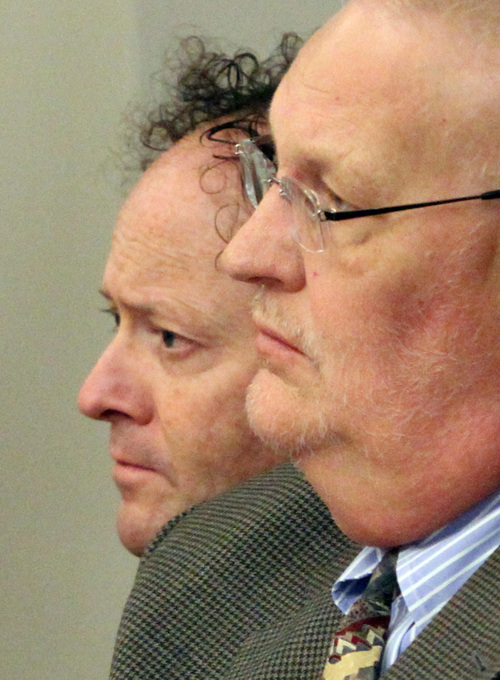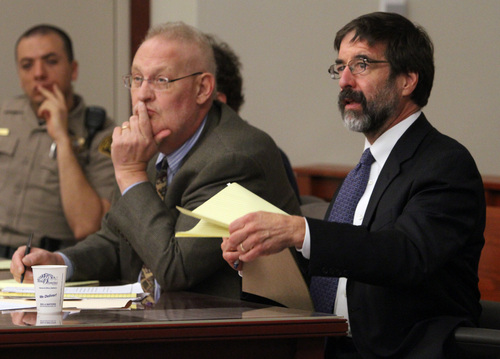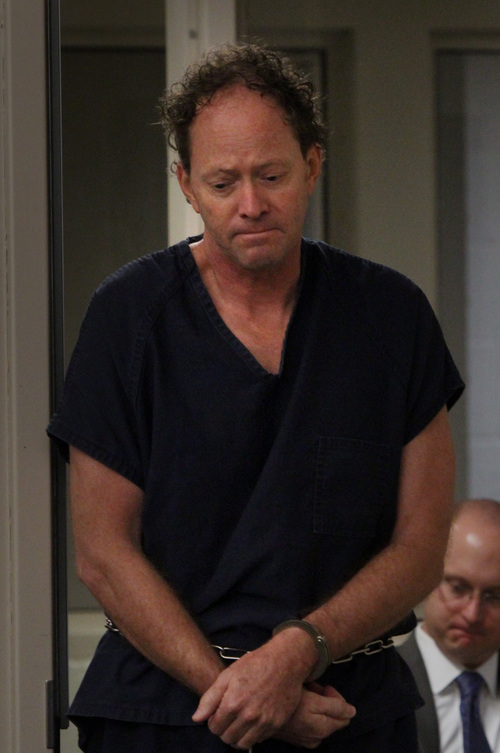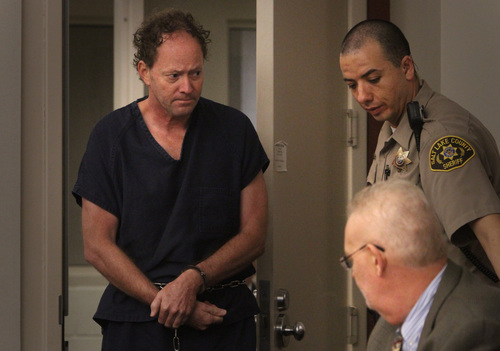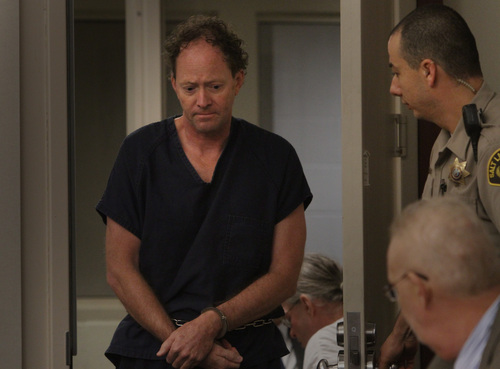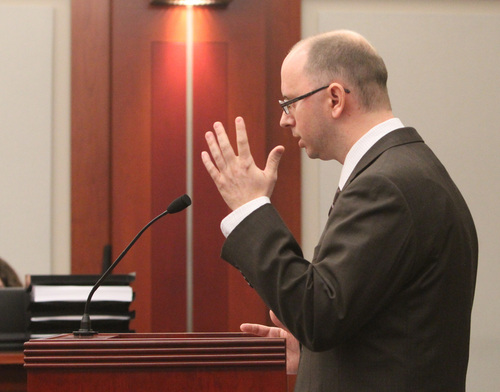This is an archived article that was published on sltrib.com in 2013, and information in the article may be outdated. It is provided only for personal research purposes and may not be reprinted.
The doctor barely lifted his head Thursday as a judge ordered him to stand trial in the 2011 murder of his ex-wife.
John Brickman Wall sat staring at the floor, his face drawn, expression clouded and worn.
His attorneys said he felt "discouraged," that he had hoped the case would be tossed for what defense attorneys have called speculative and circumstantial evidence that isn't enough to prove Wall had anything to do with his ex-wife's demise at her Salt Lake City home.
"Dr. Wall has maintained his innocence from the very beginning, " defense attorney Fred Metos said after Thursday's hearing. "[Prosecutors] haven't offered a plea deal, and I don't think it's likely that they will. I highly doubt this case can be resolved any sort of plea."
But 3rd District Judge Robin Reese ruled Thursday there was enough evidence to show that the death of Uta von Schwedler was, indeed, a murder and that Wall was likely the person who committed it.
"There are signs of a struggle inside the deceased's bedroom," the judge said as he issued his ruling. "The defendant was angry at [von Schwedler] over a long period of time."
The threshold of proof is lower in preliminary hearings, as the judge's ruling is based on a whether prosecutors have shown "probable cause," which is much less than the "beyond a reasonable doubt" standard required for a jury verdict.
But prosecutors said after the hearing they're confident in the case they've built against the Utah pediatrician.
"We're very pleased with the bind-over ruling," said prosecutor Matt Janzen. "All cases are difficult, but I believe we can prove what we need to prove here."
Wall, 49, is charged with first-degree felony counts of aggravated burglary and murder — crimes for which he could be sentenced to up to life in prison.
Throughout the course of the two-day preliminary hearing, the judge heard testimony from those who knew the Salt Lake City couple before and after their contentious divorce, medical and forensic experts, investigators and the man who found von Schwedler's body in her bathtub.
Of all the evidence, the most hotly debated was that of the medical examiner.
Despite wounds to von Schwedler's body that appeared more like defensive-wounds — the kind of injury obtained in a physical struggle — than wounds one would inflict on their own body, medical examiner Erik Christensen could not rule von Schwedler's death a homicide.
Because it wasn't clearly a suicide, either, he declared her manner of death "undetermined."
"This is a woman with no known suicidality, whose friends and family describe as upbeat, making future plans," Christensen said. "But usually, suicide is an impulsive, private act. I'm not comfortable saying it couldn't be that."
Prosecutors declined to comment about how they would overcome this uncertainty should the case be brought before a jury. But in closing arguments Thursday, Janzen said the medical examiner's report was simply a "medical determination, not a legal one."
He pointed to the big picture supporting their claim that Wall killed von Schwedler:
"There was a building level of frustration [with von Schwedler]. ... He doesn't confess in his police interview because there's a part of him that just doesn't want to say that he did it," Janzen said. "There is a covering up and a cleaning up of the crime scene. A person who's committing suicide doesn't clean up and cover up the evidence. That happens in a homicide."
A brutal custody battle gave Wall the motive to do it, Janzen said. He was seen by several witnesses at odd times doing odd things around the time von Schwedler likely died — like moving a garbage can by his home at 1 a.m., after he told officers he had slept the entire night outside.
"He had the opportunity. He was out late at night," Janzen said. "His reaction to [the police] confronting him about witnesses seeing him and having DNA evidence was he started to sweat. And now we have that evidence."
Von Schwedler, 49, was found dead in the bathtub of her home on Sept. 27, 2011. She was an AIDS researcher at the University of Utah and a mother of four.
Nils Abramson, who was von Schwedler's boyfriend at the time of her death, discovered her body.
Photos presented on the first day of testimony Tuesday showed von Schwedler's body as it was the day Abramson found her, Sept. 27, 2011.
The tub, he testified Tuesday, was full of ice cold water. The faucet was running. A scrapbook with photos of her youngest daughter floated near her feet. Beneath her body, there was a knife.
In the months after von Schwedler's death, police struggled to determine whether she was the victim of suicide or murder.
Although the wounds to her body didn't appear to be self-inflicted and there were signs of a bloody struggle in the home, there were no signs of forced entry and von Schwedler had a toxic amount of Xanax in her system.
"The problem with homicide is, how did she get Xanax in her system?" Christensen asked. "I don't have a good answer for that."
Abramson, who is a social worker by trade, testified that von Schwedler did not display any signs of suicide or depression prior to her death. She was not on any medication — aside from something to treat her seasonal asthma — and was never prescribed Xanax, according to court documents.
In making his ruling Thursday, the judge pointed out that the only person involved in this case who had documented access to Xanax was the defendant, who had written his mother a prescription for the drug several months before von Schwedler's death.
"The defendant admitted the prescription never got to his mother," the judge said. "It also seems unusual that the defendant couldn't categorically and unequivocally tell police, friends and neighbors that he didn't kill his ex-wife."
The autopsy of von Schwedler's body revealed several injuries, including bruising to her lips, scrapes to her right cheek, cuts and puncture wounds, several of which Christensen said he had "never seen anything like this in a suicide."
The woman's internal neck muscles also were injured in a way that prosecutors argued may have been the result of someone holding von Schwelder down as they force-fed her the drugs.
Throughout the house, bloody footprints seemed to have been wiped away, and could only be seen using technology that detects trace proteins, testified lead detective Cordon Parks. A blood stain on von Schwedler's bed was covered by a pillow and her bloody tank top was folded up so the stain was not visible.
"Somebody lowered the blinds, turned off the light and cleaned up the blood on the floor," Parks said Wednesday. "There was clean-up of the crime scene, even after the blood was dropped."
Expert analysis of the crime scene also revealed Wall's DNA in the home, which he did not share with his ex-wife.
But Metos has pointed out the kind of DNA found could have also belonged to either of von Schwedler's sons. The expert agreed.
"It's not a full profile," Metos said Thursday. "It's a possible match."
In the aftermath of von Schwedler's death, Wall was seen with scratch marks to his left eye, forearms and ankle.
Prosecutors claim the marks were from von Schwedler fighting back as Wall killed her. But Wall has said he suffered red marks from working in his rose garden and being scratched by his black Labrador, Molly.
As Metos asked the judge to dismiss the case Thursday, one of von Schwedler's sisters sat in the back row of the courtroom gallery. She was knitting.
Wall's sister, who was present each day of this week's hearing, sat behind her brother, her pen moving furiously across paper.
The couple's 19-year-old son, Pelle Wall, who has made national headlines for his unwavering support of his mother and insistence that his father killed her, did not return after the first day of testimony.
John Wall remains behind bars in lieu of a $1.5 million cash-only bail.
Twitter: @Marissa_Jae


